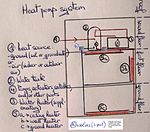- Deep water source cooling
-
Deep water source cooling (DWCS) or deep water air cooling is a form of air cooling for process and comfort space cooling which uses a renewable, large body of naturally cold water as a heat sink. It uses water at a constant 277 to 283 kelvins (4 to 10 degrees Celsius) or less which it withdraws from deep areas within lakes, oceans, aquifers and rivers and is pumped through the primary side of a heat exchanger. On the secondary side of the heat exchanger, cooled water is produced.[1]
Contents
Advantages
Deep water source cooling has several advantages:
- It is very energy efficient, requiring only 1/10 of the average energy required by conventional cooler systems.[2]
- It does not use any ozone depleting refrigerant. This is still an important feature, despite the fact that smaller/less expensive ecologic cooling devices also exist.
Disadvantages
Several disadvantages are also present:
- It requires the presence of a (fairly) large and deep water quantity in the surroundings. To obtain water in the 3 to 6 °C (37 to 43 °F) range, a depth of 66 meters (217 ft) is required.[3]
- The set-up of a system is expensive and labor-intensive. The system also requires a great amount of source material for its construction and placement. For example, the pipes alone can range several hundreds of meters or feet when placed end to end.
See also
References
- Sudick, Jennifer (Vol. 13, Issue 15 - Tuesday, January 15, 2008). "New seawater cooling plant in the works". Honolulu Star-Bulletin. http://starbulletin.com/2008/01/15/business/story03.html. Retrieved 2008-04-26.
- Long Beach Press-Telegram , April 7, 2005, USING COLD SEAWATER FOR AIR-CONDITIONING
External links
Categories:- Ocean energy
- Heating, ventilating, and air conditioning
Wikimedia Foundation. 2010.


